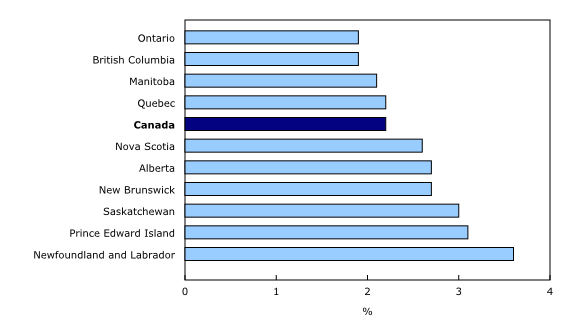Study: Income Growth per Capita in the Provinces since 1950
Archived Content
Information identified as archived is provided for reference, research or recordkeeping purposes. It is not subject to the Government of Canada Web Standards and has not been altered or updated since it was archived. Please "contact us" to request a format other than those available.
Released: 2019-05-23
According to a new study, from 1950 to 2016, real gross domestic income (GDI) per capita grew fastest in provinces with large oil and gas deposits, such as Alberta (+2.7% per annum based on a compound annual growth rate), Saskatchewan (+3.0% per annum) and Newfoundland and Labrador (+3.6% per annum)—and in provinces that had the lowest current dollar gross domestic product (GDP) per capita values in 1950, such as Prince Edward Island (+3.1% per annum), New Brunswick (+2.7% per annum) and Nova Scotia (+2.6% per annum).
A new study from Statistics Canada examines GDP per capita and real GDI per capita over a 66-year period to provide insight on which provinces experienced the most growth over the course of three generations, and how this affected per capita income levels across provinces. It uses a new dataset designed to facilitate long-run examinations of regional economic performance.
Oil and gas producing provinces move to the top of provincial income rankings
The study documents a re-ordering of provincial income levels over time. In 2016, the major oil and gas producing provinces of Alberta, Saskatchewan and Newfoundland and Labrador had the highest levels of GDP per capita relative to that of Canada, followed by Ontario and British Columbia.
This ranking was considerably different in 1950, when Saskatchewan and Newfoundland and Labrador had GDP per capita below that of Canada, and the highest GDP per capita values relative to Canada's were in Ontario and British Columbia.
Although the Atlantic provinces had lower GDP per capita relative to that of Canada in both 1950 and 2016, their relative position has improved. For example, GDP per capita in Prince Edward Island relative to Canada's rose from 44.8% in 1950 to 75.3% in 2016.
Latest commodity cycle was smaller than the cycle in the 1970s/1980s
Analysis of data covering long time periods is important because it allows current events to be viewed from an historical perspective. Canada has been subject to long commodity cycles, and real income growth over these cycles can be compared using the long-run data.
For example, the commodity boom over the 2000s was marked by record high oil prices and strong real income growth in Alberta. But relative to the oil shocks of the 1970s, the increase in Alberta's real income was less than half as large. Moreover, it was less permanent, with a cumulative increase of a little over 11% in real GDI per capita from 2002 to 2015, compared with a cumulative increase of over 60% in the 1970s.
Note to readers
This study uses a new dataset designed to facilitate long-run examinations of regional economic performance, and is made available in Table 36-10-0229-01. The new dataset builds on the work conducted in the Canadian System of Macroeconomic Accounts and by Brown and Macdonald (2015) to extend the time component of modern measures of provincial and territorial aggregate income back to 1950. The dataset contains per capita estimates for the following: gross domestic product (GDP), including income components and final expenditure components; deflated components; real gross domestic income (GDI); and important ratios, such as the saving rate and the unemployment rate. These data allow major questions about regional growth over extended periods of time to be examined.
Real GDI is a measure of real income that deflates current dollar GDP using the final domestic expenditure price index. It is a real income measure that accounts for real changes in production (real GDP) as well as a trading gain that comes from differential price changes for export and imports (the terms of trade) and traded and non-traded goods and services prices (the real exchange rate).
Products
The research article, "Income Growth per Capita in the Provinces since 1950," which is part of Economic Insights (11-626-X), is now available.
Contact information
For more information, contact us (toll-free 1-800-263-1136; 514-283-8300; STATCAN.infostats-infostats.STATCAN@canada.ca).
To enquire about the concepts, methods or data quality of this release, contact Ryan Macdonald (613-951-5687; ryan.macdonald@canada.ca), Economic Analysis Division.
- Date modified:



